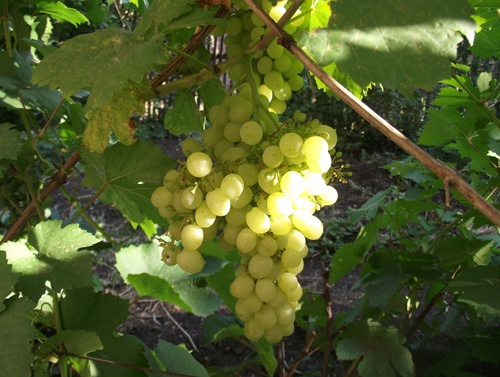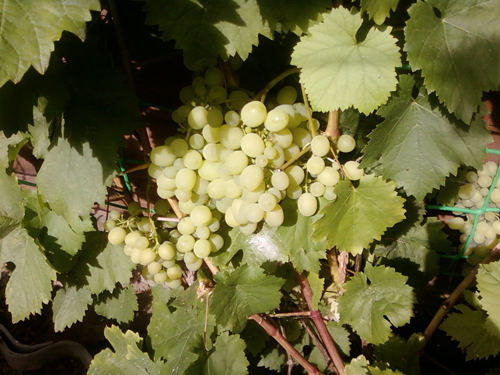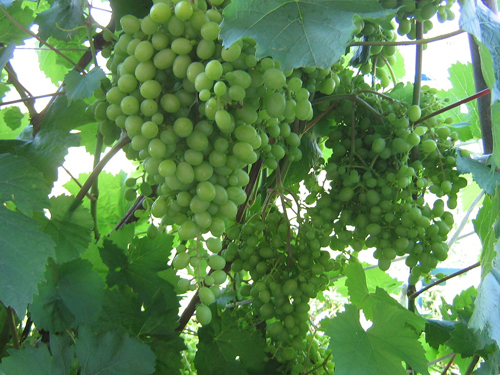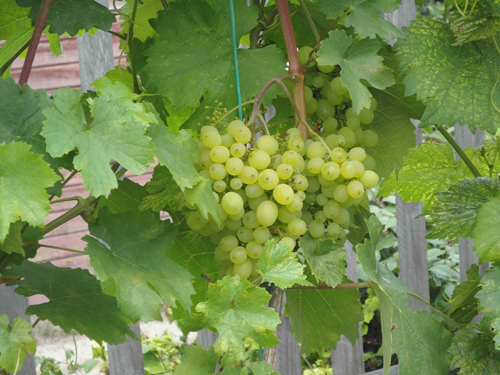Grape variety Aleshenkin (Alyosha)
Many people believe that growing grapes in the north is a futile and too troublesome business. Moreover, they say, good grapes cannot be grown there, except that frost-resistant interspecific hybrids, suitable more for landscaping than for harvesting, with any high tasting ratings. However, this stereotype completely destroys the Aleshenkin variety (or Alyosha, as it is often called), bred many decades ago, back in 1956. It not only gives a very early bountiful harvest of large bunches of grapes, but is also rightfully characterized as a dessert for the high taste of very sweet berries, which is a real miracle in a cool and short northern summer. There is evidence that even in the Arctic Circle, it bears excellent fruit, of course, taking into account the use of protected ground structures. But already at the latitude of Moscow, Nizhny Novgorod, Kazan and Chelyabinsk, the harvest has time to ripen without any greenhouses or greenhouses.

Our hero was obtained at the Volgograd experimental station by pollination of the once popular French variety Madeleine Angevin with a mixture of pollen from other table varieties. The author of the hero of our article is the famous winegrower P.E. Tsekhmistrenko. The name "Aleshenkin" Pyotr Efimovich gave the brainchild in honor of his grandson. As the son of the breeder later said, “the father valued these grapes, he really liked its qualities. But the variety, like its creator, turned out to have a “character”, fully revealing its merits only to a competent winegrower ”. Therefore, he is sure, and the attitude towards Alyosha is ambiguous: someone quite sincerely admires him, and someone is very condescending.
A similar difference in the assessments of grapes that have been comprehensively tested over many decades really does take place, and it is associated with a significant list of both positive qualities and objective gaps in the agrobiology of our hero. The latter include the low frost resistance of the root system, the peeling of berries that occurs in unfavorable years, low resistance to fungal diseases, as well as a pronounced tendency to overload the crop, requiring mandatory measures to normalize it. But, despite this, Aleshenkin was and remains one of the best varieties for northern viticulture, and this predisposition alone more than covers all the shortcomings that critics traditionally present to him.
Agrobiological characteristics
The bushes have great vigor. Leaves are medium in size, stretched in width, dark green, five-lobed with a medium degree of dissection. The surface of the leaf blade is smooth and shiny, there is no pubescence on the underside. The upper lateral notches are of medium depth, open with parallel sides and a rounded bottom; the lower ones are shallow, barely outlined. The petiolate notch is closed with a rounded lumen and a pointed bottom. The teeth along the edge of the leaf are triangular, large, with a wide base and rounded apices. The petiole is usually shorter than the main vein of the leaf. Flowers in grapes are bisexual, however, they are pollinated with their own pollen satisfactorily, demonstrating in unfavorable weather conditions during flowering years, a tendency to pea berries. At the same time, small Aleshenkin berries still accumulate sugar well, without forming seeds at all, which some growers estimate more as a specific feature of the variety, rather than an obvious drawback.

Bunches ranging in size from large to very large, usually weighing 500-1000 grams, but some often grow up to 2 kg. Their shape is conical or broadly conical, sometimes branched, the density is average. The comb is powerful, long, well developed, firmly attaches the bunch to the vine.The berries are weakly oval, medium in size (28 × 26 mm), weighing 4-5 grams, pleasant matte golden or amber color with a light protective coating of prune on the surface. The pulp is juicy, excellent crunchy consistency, very sweet harmonious taste without specific varietal characteristics in the aroma. The skin is quite thick, firm, but edible. The seeds in most of Aleshenkin's berries are present in the amount of 1-2 pieces, however, up to a third of the grapes on a bunch are completely seedless, which significantly increases their tasting characteristics. Ripe bunches of grapes, if weather conditions permit, can continue to hang on the bushes for a long time, without reducing their high consumer qualities and without being damaged by wasps.
The crop is intended for fresh consumption, as well as for obtaining a very tasty, rich, sweet juice. It works well in compotes, and original grape jam is obtained from seedless berries. Due to the dense skin and pulp of the berries, the harvest is quite transportable, but it is not suitable for long-term storage. Even in refrigerators, it can be stored for a very short period.
Very early ripening variety. Moreover, it is not so much the growing season itself from budding to ripening of grapes (110-115 days) that is outstanding, but the phenomenally small amount of heat required to obtain a harvest. The sum of the active temperatures required by Aleshenkin does not exceed 2000 ° C. For a better idea of how small this is, let us only report that a similar level of SAT is characteristic of such far from southern cities as Yaroslavl, Kostroma and Nizhny Tagil.

The yield is consistently high, it even needs to be limited to 8-10 kilograms per bush, so as not to harm itself, taking away the strength necessary for a successful overwintering with excessively abundant fruiting. The frost resistance of the aboveground part of the plants is increased (-24 ° C), however, the "Achilles heel" of this variety of grapes is the weak resistance of the root system to frost. It is difficult to tolerate low temperatures, which can cause the death of the entire plant.
The vine, provided that there is no overload of the bushes with the harvest, ripens well. The fruitfulness of Aleshenkin's shoots is very high - up to three bunches per shoot, which is a lot given the potentially large size of the brushes. The sugar content of the juice of berries at the time of ripening is high - up to 20 grams / 100 ml, while the acidity, on the contrary, is very low and amounts to 3-5 grams / liter. Such a ratio of acid and sugar determines the intoxicatingly sweet taste of the berries, which seems fantastic given the very small amount of heat required by the variety.
Agrotechnical features
The cultivation of Aleshenkin is fraught with a number of difficulties due to its varietal characteristics. First of all, as already mentioned, the root system of grapes, which is poorly resistant to winter frosts, is at risk. For the successful cultivation of Alyosha in the north, it is necessary to graft him onto frost-resistant stocks. If you have only own-rooted seedlings, then you will have to develop a mechanism for warming the soil under the bushes for many years to come, especially in regions with little snowy winters. For this, mulching the earth with a layer of leaves, straw, reeds, sawdust is suitable. Good results are also shown by abundant autumn water-charging irrigation, since wet soil, due to the high heat capacity of water, freezes to a shallower depth.

The aboveground part of the bushes of this variety must also be protected from frost in areas where winter air temperatures below -24 ° C are not uncommon. If the minimum temperatures do not deviate too much from this figure, then a light layer of heat-insulating material will be enough to cover the vine, which can be the same leaves, a needle case, straw or sawdust. If frosts in winter happen much more severe, then you cannot do without powerful two-layer shelters. The main condition for any method of protection is that Aleshenkin's vine remains dry under cover, otherwise the buds will inevitably rot and die by spring.
Another problem is the susceptibility of the variety to harmful fungal diseases - mildew and powdery mildew.To protect against them, it is necessary to carry out all the necessary fungicide treatments with high quality and in full, in accordance with the protection schemes for unstable grape varieties. As a certain prevention and reduction of the harmfulness of diseases, it is possible to advise more actively to carry out green operations in a growing vineyard - a fragment, a garter, shoots pinching and lightening of bunches in order to ensure its good ventilation, rapid drying of morning dew, which will worsen the conditions for the reproduction of pathogens.
To prevent peas, to which the variety is predisposed, apply a single spraying or dipping the inflorescences in a solution of the Gibberellin growth stimulator. This procedure will not only get rid of the problem associated with insufficient pollination, but also increase the size of all berries, and, ultimately, the overall yield of Aleshenkin.
In addition to these measures, it is imperative to carry out rationing of grape bushes with a harvest, by thinning out excess inflorescences. On a fruitful shoot, there should not be more than one brush, and in general there are 10-15 clusters on the bush, depending on their size. In addition, in the process of growing berries, you can pinch off the lower part of the largest brushes, which will also reduce the load on the Aleshenkin bush, and the bunches will ripen more evenly. If this is not done, then plants prone to overloading will not only be unable to “pull out” the crop to the required conditions, but can also leave in winter with insufficiently ripe vine, which will inevitably lead to its death in winter, despite any shelter.
Bushes are formed in a covering culture according to the multi-arm fan principle, or according to the scheme of an inclined (oblique) cordon. Stamp non-covering formations are possible only in relatively southern regions, but there the variety is less popular due to the presence of a large number of less whimsical varieties of grapes of the most varied taste, size and color of berries. In addition, in the south, Aleshenkin's berries acquire a kind of rusty blush, which somewhat spoils the presentation of the bunches.
However, all this does not detract from the merits of our hero, as a time-tested high-quality variety for northern viticulture. In harsh climatic conditions, it manifests itself in all its glory, and therefore, despite its venerable age, our Alyosha will be popular for many years and will be in demand by enthusiastic winegrowers who are ready to invest their strength and energy in growing high-quality grapes in seemingly , completely unsuitable conditions for this.








